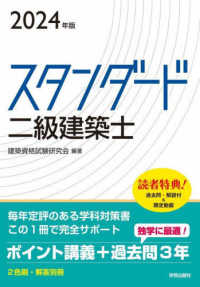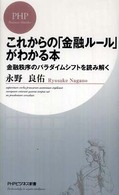基本説明
This volume interfaces three fields of linguistics rarely discussed in the same context. Its underlying theme is linguistic variation, and the ways in which historical linguists and dialectologists may learn from insights offerd by typology, and vice versa.
Full Description
This volume interfaces three fields of linguistics rarely discussed in the same context. Its underlying theme is linguistic variation, and the ways in which historical linguists and dialectologists may learn from insights offered by typology, and vice versa. The aim of the contributions is to raise the awareness of these linguistic subdisciplines of each other and to encourage their cross-fertilization to their mutual benefit. If linguistic typology is to unify the study of all types of linguistic variation, this variation, both diatopic and diachronic, will enrich typological research itself. With the aim of capturing the relevant dimensions of variation, the studies in this volume make use of new methodologies, including electronic corpora and databases, which enable cross- and intralinguistic comparisons dialectally and across time. Based on original research and unified by an innovative theme, the volume will be of interest to both students and teachers of linguistics and Germanic languages.
Contents
1. Part I: Typology and grammaticalization; 2. 'Triangulation' of diachrony, dialectology and typology: An overview (by Nevalainen, Terttu); 3. Bi-directional vs. uni-directional asymmetries in the encoding of semantic distinctions in free and bound person forms (by Siewierska, Anna); 4. Part II: Diachrony and typology; 5. Historical morphology from a typological point of view: Examples from English (by Kastovsky, Dieter); 6. Typology and comparative linguistics: Jakobson revisited (by Krasukhin, Konstantin G.); 7. Primary adjectives in English and German: Variation and change in diachrony and typology (by Schoneborn, Thomas); 8. The concessive connective albeit: A diachronic corpus-based study (by Sorva, Elina); 9. Possessives and determiners in Old English (by Allen, Cynthia L.); 10. Analytic of the samyn or synthetic its?: The use of neuter possessives in Older Scots texts (by Bugaj, Joanna); 11. Expressing human indefiniteness in English: T239ypology and markedness of pronouns (by Laitinen, Mikko); 12. Part III: Dialectology and typology; 13. Dialect and typology: Where they meet - and where they don't (by Abraham, Werner); 14. Somerset relativizers revisited (by Peitsara, Kirsti); 15. Resilient or yielding?: Features of Irish English syntax and aspect in early Australia (by Fritz, Clemens); 16. Part IV: Dialectology, typology and diachrony; 17. Negative indefinites: A typological and diachronic perspective on a Brabantic construction (by Auwera, Johan van der); 18. The relatives who and what in northern East Anglia (by Poussa, Patricia); 19. Vernacular universals?: The case of plural was in Early Modern English (by Nevalainen, Terttu); 20. Indexes








